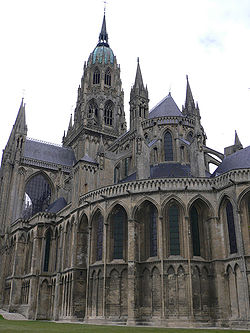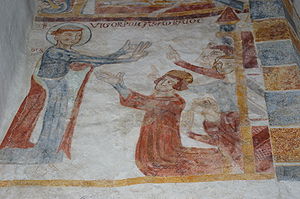- Roman Catholic Diocese of Bayeux
-
The Roman Catholic Diocese of Bayeux and Lisieux, is a diocese of the Latin Rite of the Roman Catholic church in France. The diocese is coextensive with the Department of Calvados, and is a suffragan to the Archdiocese of Rouen, also in Normandy.
At the time of the Concordat of 1802, the ancient Diocese of Lisieux was united to that of Bayeux. A pontifical Brief, in 1854, authorized the Bishop of Bayeux to call himself Bishop of Bayeux and Lisieux.
Contents
History
A local legend, found in the breviaries of the 15th century, makes St. Exuperius, first Bishop of Bayeux, an immediate disciple of St. Clement[disambiguation needed
 ], and his see a foundation of the 1st century; St. Regnobertus, the same legend tells us, was the successor of St. Exuperius, but the Bollandists and M. Jules Lair found little ground for this legend; it was only towards the middle of the 4th century that St. Exuperius founded the See of Bayeux; after him the priest St. Reverendus worked to spread Christianity in these parts.
], and his see a foundation of the 1st century; St. Regnobertus, the same legend tells us, was the successor of St. Exuperius, but the Bollandists and M. Jules Lair found little ground for this legend; it was only towards the middle of the 4th century that St. Exuperius founded the See of Bayeux; after him the priest St. Reverendus worked to spread Christianity in these parts.Certain successors of St. Exuperius were saints: Rufinianus; Lupus (about 465); Vigor (beginning of the 6th century), who destroyed a pagan temple, then still frequented; Regnobertus (about 629), who founded many churches, and whom the legend, owing to an anachronism, made first successor to Exuperius; and Hugues (d. 730), simultaneously bishop of two other sees, Paris and Rouen.
We may also mention Odon of Conteville (1050–97), brother of William the Conqueror, who built the cathedral, was present at the Battle of Hastings, intrigued for the tiara on the death of Gregory VII (1085), and died a crusader in Sicily; Cardinal Trivulce (1531–48), papal legate in the Roman Campagna during the siege and pillage of Rome by the Constable de Bourbon; Arnaud Cardinal d'Ossat (1602–04), an illustrious diplomatist prominently identified with the conversion of Henry IV of France. Claude Fauchet, who after being court preacher to Louis XVI, became one of the "conquerors" of the Bastille, was chosen Constitutional Bishop of Bayeux in 1791, and was beheaded 31 October 1793. Léon-Adolphe Amette, Archbishop of Paris was, until 1905, Bishop of Bayeux.
In the Middle Ages Bayeux and neighbouring Lisieux (later merged in) were very important sees. The Bishop of Bayeux was senior among the Norman bishops, and the chapter was one of the richest in France. The See of Lisieux maintained the Collége de Lisieux at Paris for poor students of the diocese.
Important councils were held within this diocese, at Caen, in 1042 and 1061; in the latter was proclaimed "the Truce of God". The statutes of a synod held at Bayeux about 1300, furnish a very fair idea of the discipline of the time.
Among the abbeys of the Diocese of Bayeux should be mentioned those of St. Stephen (Abbaye-aux-Hommes) and of the Trinity (Abbaye-aux-Dames), both founded at Caen by William the Conqueror (1029–87) and his wife Matilda, in expiation of their unlawful marriage. The former of these abbeys was governed by the celebrated Lanfranc, afterwards Archbishop of Canterbury. Other abbeys were those of Troarn of which Durand, the successful opponent of Berengarius, was abbot in the 11th century, and the Abbaye du Val, of which Rancé was abbot, in 1661, prior to his reform of La Trappe Abbey. The Abbey of St. Evroul (Ebrulphus) in the diocese of Lisieux, founded about 560 by St. Evroul, a native of Bayeux, is famous as the home of Ordericus Vitalis, the chronicler (1075–1141).
Saint Jean Eudes founded in 1641 in Caen the congregation of Notre Dame de Charité du Refuge, which is devoted to the protection of girls and included 33 monasteries in France and elsewhere in 1900. At Tilly, in the diocese of Bayeux, Michel Vingtras established, in 1839, the politico-religious society known as La Miséricorde, in connexion with the survivors of La Petite Eglise, which was condemned in 1843 by Gregory XVI. Daniel Huet, the famous savant (1630–1721) and Bishop of Avranches, was a native of Caen.
Bishops
To 1000
- Saint Exupère (Exuperius), 390–405, known as Spire (Spirius), Soupir, Soupierre
- Saint Regnobert (Regnobertus) or Renobert, Rennobert, Raimbert
- Saint Rufinien (Rufinianus) ...–434
- Saint Loup (Lupus) 434–464
- Saint Patrice (Patricius) 464–469
- Saint Manvieu (Manveus) or Manvé, Mange, Manvien, Mar-Wig 470–480
- Saint Contest (Contestus) or Contès, Context 480–513
- Saint Vigor (Vigorus) or Vigile 513–537
- Leucade or Leucadius 538 (Council of Orléans)
- Lascivius or Lascivus, Lauscius
- Leudovalde (Leudovaldus) or Leudovald 581–...
- Saint Gertran (Geretrandus) or Gérétran 585–625
- Saint Ragnebert (Ragnobertus) 625–668
- Saint Gerbaud (Gereboldus) or Gerebauld, Gerbold 689–691
- Saint Frambold (Framboldus) or Franbolt, Frambaud, Franbourd 691–722
- Hugo of Champagne 723–730 (also Bishop of Paris, Archbishop of Rouen, Abbot of Jumièges and Abbot of Fontenelle
- Léodeningue, c. 765
- Thior (Thiorus)
- Careville (Carveniltus) c. 833
- Harimbert or Ermbart 835–837
- Saint Sulpice (Sulpicius) 838–844
- Baltfride (Baltfridus) or Badfridus, Waltfride, Baufroy, Vaufroy, † 858
- Tortolde 859–860
- Erchambert 860–...
- Heinrich I. (Heiricus) c. 927
- Richard I.
- Hugo II. c. 965
- Radulfe III. (Radulfus, Radulphus) or Raoul "d'Avranches" 986–1006
1000 to 1300
- Hugo III. d'Ivry 1011/1015–1049
- Odo of Conteville or Eudes I. 1049–1097 (also Earl of Kent)
- Turold de Brémoy (Turoldus) or d'Envermeu 1097–1106
- Richard II. of Dover (or Richard I, son of Samson, Bishop of Worcester) 1107–1133
- Richard III. of Gloucester (or Richard II. Fitz Robert, nephew of Richard I) 1135–1142 (Rollonides)
- Philippe d'Harcourt 1142–1163
- Heinrich II. 1163–1205
- Robert des Ablèges 1206–1231
- Thomas de Freauville 1232–1238
- Guy 1240–1259
- Eudes de Lory (Odo de Lorris) 1263–1274
- Gregor von Neapel 1274–1276
- Pierre de Beneis ...–..., † 1305
1300-1500
- Wilhelm I. Bonnet 1306–1312, founder of the Collège de Bayeux in Paris
- Wilhelm II. de Trie 1313–...
- Pierre II. de Lévis. 1325–1330
- Wilhelm III. de Beaujeu 1330–1337
- Wilhelm IV. Bertrand 1338–1347
- Pierre III. de Villaine 1349–1360
- Ludwig I. Thézart 1360–1373
- Milon de Dormans 1373–1374
- Nicolas du Bos 1375–1408,
- Jean de Boissey or Jehan de Boissey 1408–1412
- Jean Langret 1414–1419
- Nicolaus II. Habart 1421–1431
- Zanon de Castiglione 1434–1459
- Ludwig II. d'Harcourt or de Harcourt 1460–1479
- Charles de Neufchâtel 1480–..., † 1498
- René de Prie or René I. 1499–..., † 1516
1500-1800
- Louis III. Canossa or Louis de Canossa 1517–..., † 1531
- Pierre IV. de Martigni 1531
- Agustin Trivulce 1531–1548
- Charles II. d'Humières 1549–1571
- Bernardin de Saint-François 1573–1582
- Mathurin de Savonnières 1583–1586
- Charles de Bourbon 1586–1590
- René de Daillon du Lude 1590–1600
- Arnault d'Ossat 1600–1604
- Jacques d'Angennes 1606–1647
- Édouard Molé 1647–1652
- Abbé de Sankte-Croix 1652–... (brother of predecessor)
- François I. Servien 1654–1659
- François II de Nesmond 1662–1715
- Joseph-Emmanuel de la Trimoille 1716–1718
- François Armand of Lothringen-Armagnac 1719–1728
- Paul d'Albert de Luynes 1729–1753
- Pierre-Jules César de Rochechouart-Montigny 1755–...
- Joseph-Dominique de Cheylus 1776–..., † 1797
- Claude Fauchet 1791–1793
- Julien-Jean-Baptiste Duchemin 1799–1799
- Louis-Charles Bisson 1799–1801
From 1800
- Charles Brault (9 Apr 1802 Appointed - 8 Aug 1817 Appointed, Archbishop of Albi)
- Charles-François Duperrier-Dumourier (13 Jan 1823 Appointed - 17 Apr 1827 Died)
- Jean-Charles-Richard Dancel (2 Jun 1827 Appointed - 20 Apr 1836 Died)
- Louis-François Robin (25 May 1836 Appointed - 30 Dec 1855 Died)
- Charles-Nicolas-Pierre Didiot (7 Apr 1856 Appointed - 15 Jun 1866 Died)
- Flavien-Abel-Antoinin Hugonin (13 Jul 1866 Appointed - 2 May 1898 Died)
- Léon-Adolphe Amette (8 Jul 1898 Appointed - 21 Feb 1906 Appointed, Coadjutor Archbishop of Paris)
- Thomas-Paul-Henri Lemonnier (13 Jul 1906 Appointed - 29 Dec 1927 Died)
- Emmanuel Célestin Suhard (6 Jul 1928 Appointed - 23 Dec 1930 Appointed, Archbishop of Reims)
- François-Marie Picaud (12 Sep 1931 Appointed - 5 Aug 1954 Retired)
- André Jacquemin (29 Oct 1954 Succeeded - 10 Dec 1969 Resigned)
- Jean-Marie-Clément Badré (10 Dec 1969 Appointed - 19 Nov 1988 Retired)
- Pierre Auguste Gratien Pican, S.D.B. (19 Nov 1988 Succeeded - 12 Mar 2010 Retired)
- Jean-Claude Ézechiel Jean-Baptiste Boulanger (12 Mar 2010 Appointed - )
Source
 This article incorporates text from a publication now in the public domain: Herbermann, Charles, ed (1913). Catholic Encyclopedia. Robert Appleton Company.
This article incorporates text from a publication now in the public domain: Herbermann, Charles, ed (1913). Catholic Encyclopedia. Robert Appleton Company.
Categories:- Roman Catholic dioceses in France
Wikimedia Foundation. 2010.


